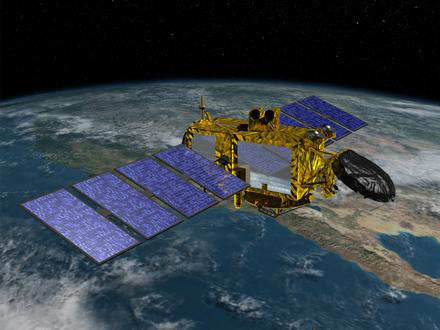
Jason-3
Jump to: Mission Objectives, Mission Instrumentation, Mission Parameters, Additional Information
Mission Photos:

Courtesy of NASA/JPL-Caltech
Mission Objectives:
The Jason-3 mission is a joint oceanography mission to monitor global ocean circulation, climate change, and sea level rise. The Jason-3 satellite is the follow-on to the TOPEX/POSEIDON, Jason-1, and Jason-2 satellites. Two other instruments, LPT and Carmen-3, will study the radiation environment at the Jason-3 altitude.
Precision orbit determination is a fundamental requirement for achieving the goals of the Jason-3 mission. The SLR data play an important role in two ways: 1) providing strong tracking information to complement GPS and DORIS and 2) providing a unique and unambiguous verification of the absolute radial orbit accuracy.
Mission Instrumentation:
Jason-3 will have the following instrumentation onboard:
- CNES Poseidon-3 altimeter
- NASA Advanced Microwave Radiometer (AMR), three-frequency
- CNES DORIS receiver
- NASA GPS receiver
- NASA retroreflector array
- Time Transfer by Laser Link (T2L2) payload
- LPT
- Carmen-3
Mission Parameters:
| Sponsor: | NASA, CNES, Eumetsat, NOAA |
| Expected Life: | 5 years |
| Primary Applications: | Oceanography and climate change |
| Primary SLR Application(s): | precision orbit determination |
| COSPAR ID: | 1600201 |
| SIC Code: | 4379 |
| Satellite Catalog (NORAD) Number: | 41240 |
| Launch Date: | January 17, 2016 |
| RRA Diameter: | 16 cm |
| RRA Shape: | hemispherical |
| Reflectors: | 9 corner cubes |
| Orbit: | circular |
| Inclination: | 66 degrees |
| Eccentricity: | 0.000 |
| Perigee: | 1336 km |
| Period: | 112 minutes |
| Weight: | 500 kg (fueled) |
Additional Information:
Web sites:
Publications:
- Bloßfeld M., Zeitlhofler J., Rudenko S., Dettmering D., "Observation-Based Attitude Realization for Accurate Jason Satellite Orbits and Its Impact on Geodetic and Altimetry Results", Remote Sensing, 12(4), 682, DOI: 10.3390/rs12040682
Other:




